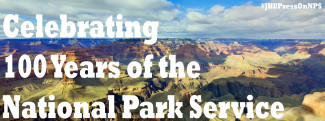
Johns Hopkins UniversityEst. 1876
America’s First Research University
Vital Spaces, Vital Places – Research in our National Parks

The National Park Service (NPS) celebrates its centennial anniversary in the month of August! NPS has served as a valuable resource for many of our authors, both professionally and recreationally. To commemorate the occasion, our authors have taken to the blog to give thanks to “America’s best idea”! Check back with us throughout the month of August for more #JHUPressOnNPS! (Series photo credit: Wikimedia)

The reasons scientists visit national parks vary, but I suspect that most of us came first as youngsters to see the beauty and grandeur of sweeping vistas. We came back for the same reasons, of course, but each visit added something new as we progressed in our careers – an appreciation for the solitude and complexity of nature, for biodiversity, for history, and for an understanding of how these landscapes and ecosystems evolved. We now use these vital areas to study and monitor the biological, chemical, geological and climatological responses to ongoing changes brought about by the Anthropocene, the Age of Man. To researchers, our national parks are not momentary attractions, but living natural laboratories.
I first visited the Great Smoky Mountains in 1972. Having returned from a year living in the Sonoran Desert, I packed my stump ripper, camera, and notebook, and drove from my home in South Carolina to Indian Gap along the Newfound Gap-Clingmans Dome road. There, I found my first red-cheeked Jordan’s Salamanders, tiny Pigmy Salamanders, and a host of other multi-colored and altogether wonderful animals. Of course I was not the first herpetologist to be drawn to these mountains, particularly to Indian Gap. It was here, after all, where the Imitator and Jordan’s salamanders had first been discovered; the Pigmy Salamander was described from nearby Mount LeConte. Great Smoky Mountains National Park is sacred ground to salamander enthusiasts.
From 1997-2001, I returned to the Smokies as leader of a project to determine the status of the park’s amphibians. As I drove from Sugarlands to Cades Cove, and after realizing how big and inaccessible the Smokies were in many areas, I had my first (but not last) misgivings. Over the course of the next four years, a team composed of enthusiastic young biologists and my recent bride hiked the hills and valleys to collect information on the species richness and distribution of the Park’s amphibians. We sampled more than 500 sites and recorded data on more than 10,000 amphibians. We were fortunate to walk in all parts of the Park, in all seasons, and in all weather conditions. Who could ever forget this experience? Priceless!
My then colleagues in the USGS Amphibian Research and Monitoring Initiative were doing the same in other National Parks: Yellowstone-Grand Teton, Olympia, Northern Cascades, Sequoia-Kings Canyon, Yosemite, Acadia, Shenandoah, Everglades, Big Bend, Point Reyes. The data they gathered have formed the basis for recognition of the precarious status of our nation’s amphibians. This information, and the research it continues to generate, could not have been obtained elsewhere. The parks are vital to our national sense of place and identity, and to our understanding of the way nature works.
The U.S. Mint has celebrated the 100th Anniversary of our National Parks by issuing a coin featuring a child turning a leaf to discover (most wonderfully!) a frog. This sense of discovery and wonder still brings scientists to the national parks, as we extend our research to conserve and protect these national legacies. We need to be vigilant in park protection, to counter those whose shrill cries call for their closure or would have them be treated as gaudy theme parks, and to ensure that the mission of the parks includes both basic and applied research, with adequate funding and administrative support. It will always be the places that remain in our minds, and it is up to us to ensure that our National Parks and Monuments remain open to future generations and conducive to preserving our native biodiversity.
C. Kenneth Dodd, Jr. is Courtesy Associate Professor in the Department of Wildlife Ecology and Conservation, University of Florida. He is the author of Frogs of the United States and Canada. 


